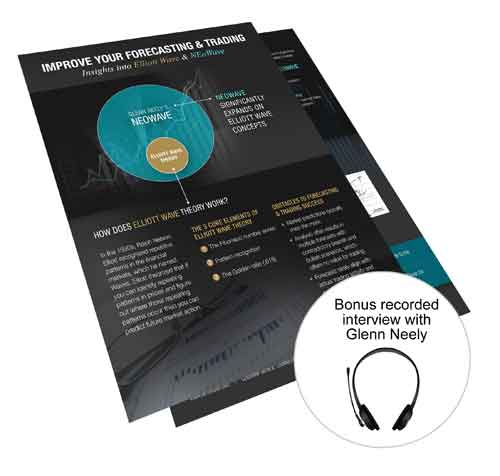NEoWave Blog
12/9/2019 - NEoWave Staff
Article #7 of 7: Glenn Neely's in-depth response to the question of Elliott Wave and spreads
Introductory note: This is Part 7 of a 7-part series. In these articles, Glenn Neely, NEoWave founder and author of Mastering Elliott Wave, discusses Elliott Wave concepts from his unique point of view as a world-renowned Elliott Wave expert. In this frank, open, and insightful interview, Mr. Neely reveals his advanced forecasting and trading concepts – based on his decades of experience as the creator of NEoWave forecasting and his exciting Neely River Trading Technology, which fuels profitable trading results.
Many clients ask about Elliott Wave and spreads. Spreads are the more complex strategy that I mentioned earlier when we were talking about Options. Spreads allow you to make money, even if the market goes up a little bit or up a lot. Let’s say you’re buying calls and you’re selling calls, or you’re buying stock and selling calls. A spread is when you buy an IN the money Option and you sell an AT the money Option. So it’s similar to buying the stock and selling a call at the money, at a spread. If it’s in a stock and an Option, then it’s called a “covered call,” so the stock is basically covered by the call to help protect against downside movement.
So there are two types. You can say a spread is long a stock and short a call. That’s really called a “cover call,” but it’s a type of spread. And then technically a real spread is you’re long the call IN the money and you’re short the call AT the money. So the short call at the money helps to bring in “rental income” (as I call it) against your long position.
The best way to use that with Elliott Wave is to use spreads during corrective environments. Let’s say you just finished Wave one and you think you’re going into a two Wave. That would be the perfect time to write a call on a long position, so that as the market goes through the correction, the Option will just lose value and you will collect all that “rental income” on your long position while you wait for Wave two to finish and then start Wave three. Then, once Wave two is over, you would exit that short call, let the market go through its next advance. Where there is evidence that Wave three is coming to an end, then you would once again write an
AT the money call against your long stock and wait through the fourth Wave. So you are making money while the market is going sideways.
This is the ONLY trading approach that allows you to make money from a sideways market. So it’s extremely handy and beneficial. If you are confident the market is going to go into a correction, that is the ideal time to enter a spread by writing a call in a bull market or writing a put in a bear market.
I recommend you do a lot of research on spreads. This is fundamental to successful trading. I’ve spent the last 3 to 4 years, virtually day and night, studying about complex Options strategy, spreads, cover calls, married puts – all these different strategies you can do in Options markets.
These trading strategies have dramatically changed my perspective on the markets. This has dramatically reduced my stress, and dramatically increased my success rate! This protects positions. It allows you to make money from sideways markets, which I could never do before. In the past it was always black or white. You were either making money or losing money. That’s it. There was no middle ground.
With Options you can be making money while nothing is happening. That is not possible with any other kind of approach. So the use of selling Options (you’re moving into a spread situation or a covered call situation) changes the entire landscape of trading. It makes it far more likely to be profitable than any other approach I’ve ever seen. And I’ve been dealing with markets for 36 years.
I highly recommend you keep reading and get educated on this topic. Plan to spend a lot of time and effort coming up to speed. In fact, I recommend spending a couple of years or more, studying all the different types of Options strategies, how to use them and when to use them before you start getting involved in it, because it is complicated.
As I’ve mentioned in this article series, the
NEoWave Trading Service already uses these strategies. Our customers sort of walk along with me, getting educated, learning about these trading strategies. As of January 2018, the NEoWave Trading Service began to incorporate Options trading and Options writing into the strategy. Plus, we have developed some very sophisticated Excel money management software that now allows me to almost consistently have 70%, 80%, sometimes even 90% of all my trades are making money. And the few that are losing money are losing very little.
Recently, I just sent an
update to NEoWave Trading customers. At that time, 76% of our trades were making money, and the losing positions were losing only a few hundred dollars. The winning were making thousands. We were making 14 times more money on the winning positions than we were losing on the losing positions. So it was a 14-to-1 profit-to-loss ratio on current open positions, with 76% of them making money.
That is the result of not only adding Options strategies to the
NEoWave Trading service, but also incorporating this sophisticated portfolio management software that I’ve developed over the last year to quickly get me out of losing positions.
In fact, I’d like to address my philosophy of capital preservation, because capital preservation is crucial to long-term successful trading. When you get into a position that starts to lose a certain amount, if it’s a stop position, if it loses say 10%, you’re going to want to start scaling out.
Around 5% you might even consider scaling out a little bit, taking off a third, 8% taking off another third, 10% taking off the final third. So that way you’re constantly getting rid of positions that are losing money and preventing them from getting worse. And when they start making money, then you’re going to protect them with Options strategies by writing calls, or buying puts, or exiting part of your position.
So you are scaling out when you’re making money up to certain points and at certain targets that are done further out than when you’re exiting a loss. You want to exit your profitable positions around three times higher than you’re exiting your losing positions, so that way you can maintain a 3-to-1 profit-to-loss ratio over time. It’s just sort of naturally built into the mathematics. And that’s the reason why NEoWave has so many winning trades, because I’m getting out of the losers really quickly.
If you’re trading, you cannot adopt a Las Vegas mentality! You don’t want to risk more than 1% or 2% of your capital per trade. You may have to spend a little more than that, but when the loss gets to around 1%, you’re going to want to start getting out.
Why? Because, if you don’t do that, any bad trade can go to zero. So you need to get out when you’re losing. Let’s say you spend 3% of your capital to get in. If you don’t get out when it’s losing 1%, it might end up losing 2%, then losing 3%, and you’ve lost all your money and all that you’ve put into it. So you have to have a target point where you get out, because it can always get worse.
On the other side, if you don’t get out until it’s up three times more than where you’re exiting, then over time, probability-wise and mathematically speaking, you will automatically have a situation where you’re going to make about three times more than you’re going to lose when you make money. And you make three times more than you’re losing when you lose money. So over time this will naturally make it a profitable endeavor.
Capital preservation is incredibly important. It’s something I really didn’t realize for at least two decades. I got a better handle on it when I started managing risk and how much I put into positions. And then I started realizing that diversification was important, so you need to trade more than just a few markets. Now I trade about 50 markets, so the diversification helps. And then you only want to spend 2% to 3% of your capital on a particular trade and then only let it lose 1/2 to 1/3 of that, so that your net loss is about 1% of your capital on any one particular trade. If you don’t get out when you’re losing a certain amount, it may just keep going and you will lose it all. As I noted earlier, capital preservation is crucial to long-term successful trading.
If you have not read the previous articles in this series, I encourage you to do so!
Read the articles in this 7-part series:
Article #1,
Article #2,
Article #3,
Article #4,
Article #5,
Article #6,
Article #7,
Get 2 educational tools FREE!
Get Real-World Advice for Better Forecasts and Trades for FREE! Sign Up Now!
Learn more about:
NEoWave Trading Service
NEoWave Forecasting Service
Mastering Elliott Wave by Glenn Neely
Follow us @NEoWaveTheory:
Twitter: https://twitter.com/NEoWaveTheory
Facebook: https://www.facebook.com/NEoWaveTheory


